Due to the lapse in federal government funding, NASA is not updating this website. We sincerely regret this inconvenience.
Launching Americans from U.S. soil, sending a new rover to Mars and continuing to prepare for human missions to the Moon are just a few of the things NASA has planned for 2020. (no spoken audio)
NASA 2020: See what the Agency has planned on Earth and beyond
NASA is making available to the public the display boards from the November 20 and 21, 2019 SEIS Public Meetings.
NASA is extending the public comment period for the Draft SEIS for an additional 30 days. The public comment period now closes on January 8, 2020.
Public comments will continue to be accepted via email to msfc-ssfl-eis@mail.nasa.gov or by traditional mail to Peter Zorba, NASA SSFL Project Director, 5800 Woolsey Canyon Road, Canoga Park, CA 91304.
As part of NASA’s continuing efforts to engage the public throughout the SEIS process, we invite the surrounding community and stakeholders to attend one of the following public meetings regarding the Draft SEIS:
The meetings will be an open house format where the public will have the opportunity to view project display boards, interact with key NASA SSFL team members, and provide formal comments regarding the Draft SEIS in writing and/or orally to a court reporter. Meeting attendees are welcome to arrive and depart to this open house event at their convenience.
The comment period continues until December 9, 2019, and the public, including those unable to attend a public meeting, can submit formal comments via email to msfc-ssfl-eis@mail.nasa.gov or via mail to Peter Zorba, NASA SSFL Project Director, 5800 Woolsey Canyon Road, Canoga, Park, CA, 91304.
NASA has issued a Notice of Availability in the Federal Register for the Draft Supplemental Environmental Impact Statement (SEIS) that evaluates the impacts reasonable soil cleanup alternatives would have on the community and the natural and cultural resources found at SSFL. The Draft SEIS has been prepared because there are significant new circumstances relevant to environmental concerns since the original Environmental Impact Statement was published in 2014.
NASA has prepared a Fact Sheet for the Draft SEIS summarizing the purpose and need for a SEIS, the Alternatives evaluated, and a brief overview of the findings.
Public comments on the Draft SEIS will be accepted October 25 - December 9, 2019 and can be submitted via email to Peter Zorba, SSFL Project Director, at msfc-ssfl-eis@mail.nasa.gov . Please see the NOA for a list of locations where a hard copy of the document can be reviewed.
As part of NASA’s continuing efforts to engage the public throughout the SEIS process, we invite you to attend one of the following public meetings regarding the Draft SEIS, where the public can ask questions about the document, and have the opportunity to provide comments:
NASA has published its October 2019 FieldNOTE newsletter. This edition of the FieldNOTE provides updates on progress with demolition and test stand preservation, NASA’s ongoing soil Supplemental Environmental Impact Statement evaluating the impacts of soil cleanup, and NASA management’s recognition of the NASA onsite SSFL team for their swift action following the Woolsey Fire.
On November 8, 2018, the Woolsey Fire started in the Santa Susana Mountains above Simi Valley near the boundary between Los Angeles and Ventura Counties. The Woolsey Fire burned approximately 96,950 acres of land, including approximately 80 percent of NASA-administered Area II at the Santa Susana Field Laboratory.
NASA safely evacuated all onsite personnel and contractors, and fully cooperated with authorities and emergency responders. The fire resulted in numerous downed power lines and burned oak trees in the NASA areas at SSFL. In addition, all of NASA’s pipeline for the onsite Groundwater Extraction Treatment System (GETS) burned, and NASA’s onsite office lost all electrical power.
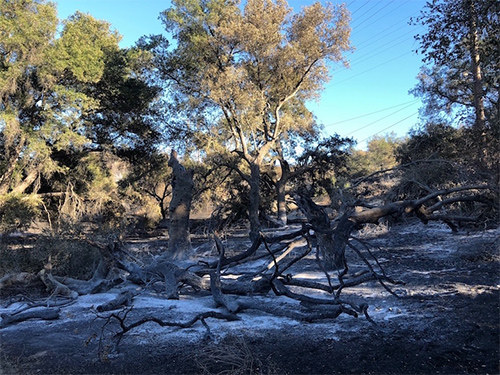
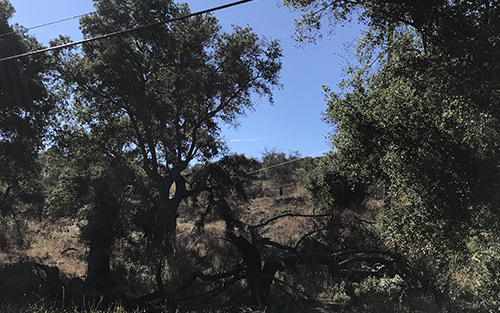
In the immediate aftermath of the fire, NASA personnel and contractors focused on re-establishing safe working conditions by clearing roadways of downed trees and power poles. A generator was brought onsite to power the NASA Site Management Office. NASA installed new, or made improvements to, the existing stormwater best management practices (BMPs) and groundcover to reduce erosion and to slow runoff during rain events. Once site conditions were safe and full access to NASA areas was restored, project teams began conducting more detailed investigations to examine fire impacts. For example, NASA collected soil and ash samples and accessed data from the four NASA air monitoring stations located on the perimeter of the SSFL site, and technical and subject matter experts conducted detailed assessments of historical and cultural resources and project facilities and infrastructure.
The Woolsey Fire swept through the NASA Test Areas, including all three eligible historic districts. All test stands and associated control houses at Alfa, Bravo and Coca Test Areas were burned by the fire but remain structurally intact with no damage beyond scorch marks near pedestals and a burned wooden staircase at Alfa Test Stand 1. A conditions assessment of the Burro Flats Area (CA-VEN-1072) conducted by an archeologist and a Native American monitor revealed that the main Burro Flats Painted Cave panel containing polychromatic pictographs and petroglyphs sustained no significant damage. However, one pictograph panel located in proximity to the site was lost due to excessive heat. In early 2019, NASA completed a pedestrian survey of the burned areas near existing cultural resources to identify and record any new resources made visible by the removal of the vegetation in burn areas.
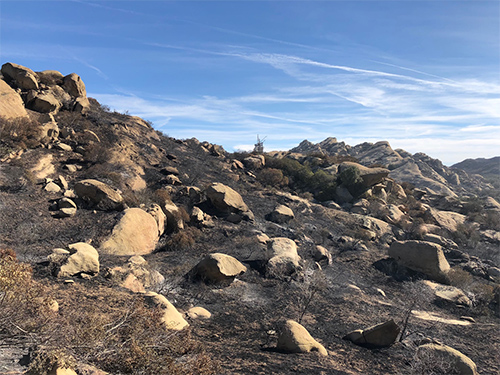
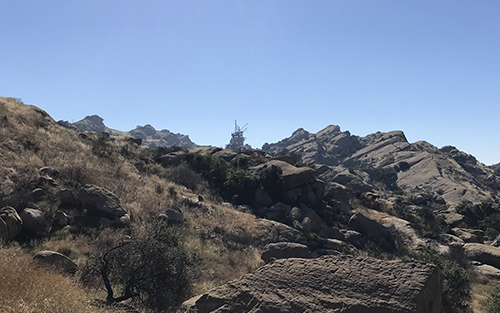
The Woolsey Fire resulted in nearly a complete loss of the electrical distribution system in the NASA-administered area of SSFL. NASA is currently replacing the distribution lines in Area II. This updated system will use the latest technology and meet or exceed current construction codes, and prioritizes fire prevention and safety. As part of its fire prevention efforts, NASA will clear a 12-foot area around each of the NASA-owned power poles and place a vegetation barrier, topped with gravel. This will create a vegetation-free buffer around each power pole to prevent the growth of vegetation against the wooden poles. In addition, NASA re-evaluated system pathways during the design phase and developed a system with fewer poles and wires, further enhancing fire prevention efforts and reducing the manmade footprint onsite. To date, NASA has removed and replaced 32 power poles and anticipates replacing up to eight additional poles. NASA expects to complete the updated power distribution system by end of 2019.
Another ongoing reconstruction project is the removal and replacement of the GETS pipeline that burned in the fire. The GETS consists of groundwater extraction wells and a network of pipelines that deliver groundwater to a treatment facility located in Area I (owned by Boeing). The treatment facility contains a number of technologies including ion exchange, air stripping, and liquid and vapor phase carbon, which remove chemicals from groundwater. The Woolsey Fire resulted in nearly a 100 percent loss of the aboveground GETS pipeline in NASA Area II. In the months since the fire, NASA has removed approximately 14,000 feet of damaged pipeline in preparation for the installation of the new pipeline. Although the system was not running at the time of the fire, NASA conducted sampling prior to removal and affirmed that there was no contaminant release. With the rebuilt pipeline system, NASA will continue to use double containment piping to protect against leaks from primary piping. NASA is coordinating with Boeing to begin testing the system this summer. The entire GETS system is expected to ready for operation by the end of 2019.
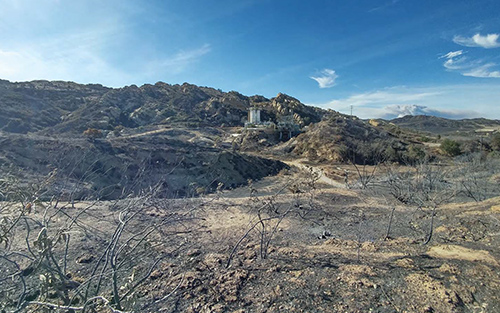
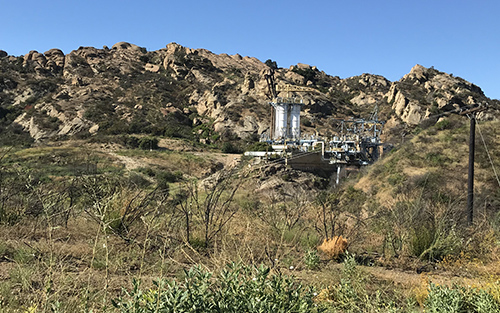
NASA submitted air quality and other data to the Department of Toxic Substances Control (DTSC). The DTSC analyzed these and additional data gathered from field inspections, computer simulations, and sampling onsite and in nearby communities and determined that no radiation or hazardous materials from SSFL were detected in the communities following and that the fire did not present any risks other than those normally presented in a wildfire situation. In December 2018, the DTSC published their findings in an Interim Summary Report of the Woolsey Fire  . NASA has also fully cooperated with the State fire authority Cal Fire, the California Public Utilities Commission (CPUC) and other fire investigators working to determine the origin and cause of the Woolsey Fire. Cal Fire is expected to release a report summarizing the results of their investigation in the near future.
. NASA has also fully cooperated with the State fire authority Cal Fire, the California Public Utilities Commission (CPUC) and other fire investigators working to determine the origin and cause of the Woolsey Fire. Cal Fire is expected to release a report summarizing the results of their investigation in the near future.
View the daily progress of the demolition of the inactive hyrdogen tank located in the Coca Test Area. (no audio)
CEI - NASA Santa Susana Coca Hydrogen Ball Demolition
NASA is going to the Moon by 2024. Watch this video to learn how.
NASA has published a Notice of Intent (NOI) in the Federal Register to prepare a Supplemental Environmental Impact Statement (SEIS) to the 2014 Final Environmental Impact Statement (FEIS), Proposed Demolition and Environmental Cleanup Activities at the SSFL . NASA will prepare this SEIS to comply with National Environmental Policy Act (NEPA) regulations, and as a result of scientific data gathered from NASA’s soil investigation since 2014. NASA made the decision to supplement the soil cleanup evaluation published in its original 2014 FEIS because the estimated quantity of soil required to be removed has increased substantially. The NOI confirms NASA’s commitment to achieving a Santa Susana Field Laboratory cleanup that is protective of public health and the environment, based in science, technically achievable and is protective of the surrounding community and the natural environment. For more information on the NEPA process and NASA’s NEPA Program: https://www.nasa.gov/green/nepa.